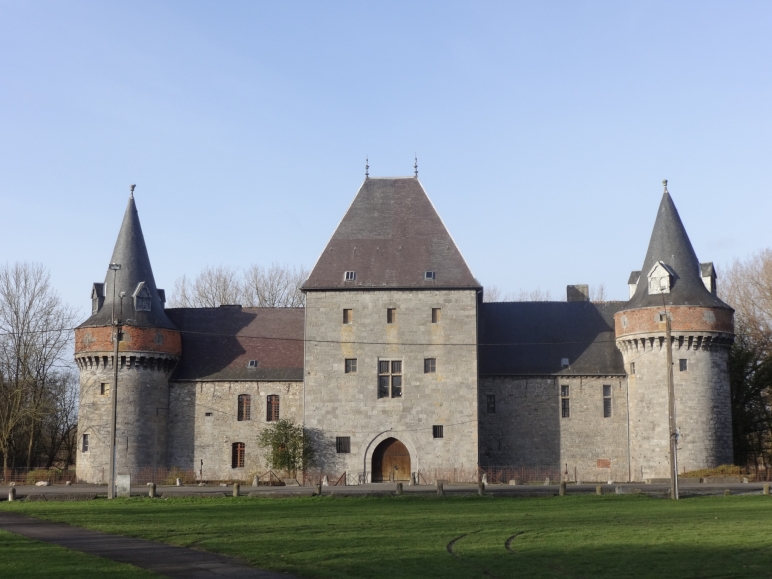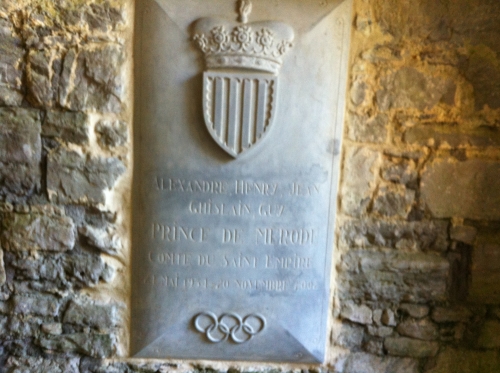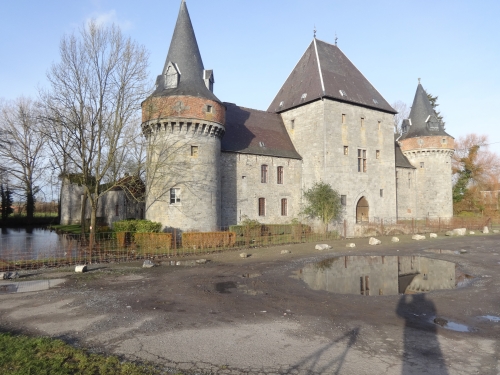Property of Princes de Merode for more than 260 years
Updated : 2025.01.25
Table of contents
1 - Forteress and Architecture
2 - The legende of the two towers in ruin og the castle of Solre-sur-Sambre
3 - The various owners of the castle
House de Barbançon from 1244 to 1410
House de Mortagne from 1410 to 1480
House de Carondelet from 1480 to 1628 (during 148 years)
House de Merode from 1628 to 1857 (during 229 years)
House de Wignacourt from 1857 to 1989 (during 132 years)
House de Merode since 1989
4 - Can you visit the castle?
5 - External Links
Over the castle of Solre-sur-Sambre
Over the Prince family de Merode
Over medieval castles
Other Castles in the region of Solre-sur-Sambre
Over the region of Solre-sur-Sambre
Restaurants in the region of Solre-sur-Sambre
Over Castles
Others
6 - Pictures
7 - How to reach the Castle?
1 - Fortress and Architecture
The Castle of Solre-sur-Sambre was built between the end of the 13th and the beginning of 14th century, and was altered several times throughout the ages. It is a local architectural masterpiece. Magnificiently preserved, it posses the typical architecture of the medieval castles surrounded with ditches supplied by the Thure river. It is located at the confluence of Thure and Sambre.
The large quadragular donjon is pierced with small openings which were used for defensive purposives. On the one hand, this donjon defended the county of Hainaut against France and on the other hand, against the principality of Liege. According to the famous Tanghe, it dates from XIIIème century. We can notice above the entery porch a window with a typical old styled crossed stone.
As an important witness of the medieval military architecture of Hainault, the castle Solre-sur-Sambre preserved the quadrilateral groundplan with circular towers in the four corners and an impressive donjon in the front, wich gives access to the inner courtyard.The four circular towers fortified the corners. The two towers of the south side are destroyed(see legend below ). The two towers of the north side are in excellent condition.
This six hundred years old fortress undoubtedly sustained well the ravages of time.
The blue stone donjon defended the inner courtyard supported by the two towers in the northern corners. Initially there was no communication between the groundfloor and the first floor unless a retractable ladder.This lack was solved only much later.
On the ground the donjon has a surface of 12,70 m by 11,50 m and the walls according to the height are more than 1,65 m to 2,30 m thick. The appearance of the donjon construction at the village square side seems to go back to the seventeenth century, while the face on the
courtyard side has kept its original structure.
The traces of a drawbridge disappeared, but her former existence is attested by files. The bridge today is constructed in hard stone.
In the XIV th century the donjon was rather quickly increased with towers in the corners of a surface delimited by a castle-moat supplied by the river Thure.
Originaly there were undoubtly palisades to establish the link between the different elements to enclose the courtyard of 47 X 44 m. Afterwards they were replaced by bricks or limestone blocks depending on the zone of construction in the connecting walls.
Initialy the massive towers of the south were build three floors high Around 1487 Jean de Carondelet added a floor with corbelled machicolation and perforated with peep- and loopholes.
The roofs in pepperpot form with coyaus have four attic windows.
The purpouse was to increase the habitable space and the comfort.
But still today there is no central heating, however the chimneys work well.
The two destroyed towers originaly had also three floors. The groundfloor of the towers serves as a cellar and the intramural staircase gives access to the floors. The circular walkway posed on semicircular arches was still visible untill sixty years ago. Shortly after the construction of the enclosure the seigneurial residence was build on the western side of the donjon.
The castle chapel mentioned since 1410 disapeared. We have to wait untill 1593 for the construction of the residences on both sides of the donjon.
The dual access to the village square was realised in the XVIII th century.
Over time two small buildings were erected on the left and right side walls of the courtyard.
The castle, situated on the square of the village Solre-sur-Sambre, contributes, with its rigorous austerity and sobriety, to the beauty of this charming town.
It is considered by many specialists and admirers of architecture as one of the best conserved and most beautifull fortified castles of the province of Hainault.
The quality of the major characters and the power that exercised the owners of the castle ( you will discover them below ) emphasises the importance of Solre-sur-Sambre.
Solre-sur-Sambre is a village in the province of Hainaut in Belgium. It is located at 2 km from the french border, at 11 km from Beaumont town, 13 km from Binche town, 25 km from Mons town and 16 km from Maubeuge town in France.
2 - The legend of the two ruined towers
of the castle of Solre-on-Sambre.
A long time ago, according to the legend, the lords of Solre-sur-Sambre and Neuville were in a perpetuel conflict about a hunting-ground located between Solre-sur-Sambre and Merbes-le-Château formerly called Merbes la Poterie. This place was called " The Fields of Préïl " and was mainly coveted for its waterfowl that bred there easely.
The lord of Solre claimed the hunting-rights on his grounds located on the right bank of the river Sambre between Jeumont and La Buissière, while the lord of Neuville pretended to have inherited the hunting-rights on the fields of Préïl. It was a long story of bloody fighting between the two
parties with battles that mostly ended on a status quo and many needless deadly victims.
An enormous drought struck the region and caused a great famine.
The lord of Neuville then took the initiative to cross the dry river Sambre in order to hunt with his forces on the fields of Préïl. As soon as the lord of Solre was informed, he gathered his troops and again a bloody strugle ensued.
The fight quickly turned short and the lord of Solre was soon forced to bring back his troops and his family into the towers of the castle.
At nightfall the lord of Neuville surrounded the fortress of Solre-sur-Sambre.
The battle was postponed to the next day. However the heavy losses in both camps calmed the minds and the next day the lord of Neuville proposed a compromise.He promised to save the life of the people and the lord of Solre was allowed to keep his property on condition that he would sign a contract that permitted his suzerain to hunt on the Fields of Préïl. He also required the demolition of the two towers inorder to secure safe hunting in this area.
The lord of Solre, more than happy to be able to save his people and to keep his land, signed the agreement as soon as possible.
And so, according to the legend, the two demolished towers of the castle of Solre-sur-Sambre
were never rebuild, even after the disappearance of the seigniory of Neuville.
This legend has, as far as we know, not been confirmed historically.
Documents of this period are of course very rare and they are not in our possession.
It seems that the name of Solre-sur-Sambre comes from the Celt " sol-ara " that means muddy water as the wetlands we were talking about. The word Sambre comes from the river Sambre wich flows through the village.
3 - The various owners of the castle.
House de Barbençon from 1244 to 1410:
The first document found on Solre-sur-Sambre is dated 1093.
At that time, the land of Solre-sur-Sambre belonged to the Lord of Barbençon, a powerful feudal family who later died in the family de Ligne. Even today, the family de Ligne carries the title of Prince of Barbençon. The first Lord of Solre-sur-Sambre was Barbençon Nicolas II who died in 1256. He founded the Abbey of Thure in the south of the village.
Arnold de Barbençon died in 1410 and was the last owner of this family.
House de Mortagne from 1410 to 1480:
His daughter Catherine married Gilles de Mortagne II. It is through this marriage that the property came into the House of Mortagne.Gilles II was quartered on the square of Mons in 1433 for conspiracy against Philip the Good (1396-1467). All his properties, including the Castle Solre-sur-Sambre and the castle of Potelle (now in France and 49 km from Solre-sur-Sambre) were confiscated and given to Antoine de Croy (1385-1475), says the Lord the great and of le Roeulx.
The latter hastened to sell them to the brother and the sister of Gilles de Mortagne three years later.
Antoine de Mortagne was the last owner of this family.
House de Carondelet from 1480 to 1628 (during 148 years):
Approximately in 1480, the castle of Solre-sur-Sambre was purchased by Jean Carondelet (1429-1501). The castle went in the house of Carondelet.
Jean de Carondelet was the first president of the Parliament of the Netherlands created by Charles the Bold (1433-1477) in 1473. He was then appointed Lord Chancellor of Flanders and Burgundy to the Archduke Maximilian of Habsburg in 1480. He married Anne of Parma and got 6 sons and 5 girls.Very few of this descendants survived and early 17th century, the family was on the limits of extinction.
His son Claude heritade the manor of Solre.
His little-son of Ferry Carondelet (1473-1528) was the brilliant advisor of Marguerite of Austria (1480-1530), the regent of the Netherlands. He had even had the honor of having a huge and beautiful tomb in the Cathedral of St. John in Besancon.
The castle of Solre-sur-Sambre belonged to this very powerful family for 148 years.
Guillaume de Carondelet and his wife, born Helena van der Steen, had a daughter only child, Anne de Carondelet, lady of Solre and Vicomtesse de Wauvremont.
House de Merode from 1628 to 1857 (during 229 years):
The very young Anne-Francoise de Carondelet (1615-1668) married 28 november 1629, the very young Maximilien-Antoine, count de Merode, Marquis de Montfort and Deynze (07 December 1611-11 November 1670).
The castle Solre-sur-Sambre passed like endows marriage to the House of Merode.
Maximilien-Antoine was governor of the Sambre and Meuse, Lord of Hamme-sur-Heure, Rocquignies, Sautour, Duffel, ect. Thanks to his marriage to Anne, he was also Viscount of Wauvremont, Lord of Solre-sur-Sambre and Crupet in 1667.
The property went then to his little-son, Maximilian Francis (1661-1725) and Therese (1695-1725) who married, in 1715, his cousin Joachim Maximilian of Merode (1690-1748).
Their son Jean-Charles (1719-1774) married Princess Marie-Charlotte d'Arenberg (1722-1776). They got no children.
The sister of Jean-Charles, Marie Philippine de Merode (1721-1769) inherited their goods.She married Otto-Henri d'Oignies. Their daughter Mary Oignies-Mastaing, Princess of Grimberghe (1760-1842), only child, married Charles Guillaume de Merode (1762-1830). He was the only Merode of his generation alive at that time. He was Grand of Spain First Class, Imperial and Royal Chamberlain, member of the Imperial Senate of France, Grand Marshal of the Court of the Netherlands.
Their second son, Felix inherited the castle in 1830. During the Belgian Revolution of 1830, Count Felix de Merode lived there. Count Felix de Merode (born in Maastricht 13 April 1791 and died in Brussels on 7 February 1857) was a member of the temporaly belgian's government, senator and deputy, Minister of State and participated in drafting the Belgian constitution.
The crown of the future Kingdom of Belgium was even proposed to him by many.
His brother Werner de Merode inherited the castle of Ham-sur-Heure. This castle has been owned 454 years by the de Merode before beeing sold by the family d'Oultremont to the municipality in 1956. The two castles are separeted by 28 kms.
House de Wignacourt from 1857 to 1989 (during 132 years):
Marie-Théoduline de Merode (born 22 July 1817 Villersexel and died in Paris 26 Feb 1909) married August 9, 1843 Alof, Marquis de Wignacourt (1815 - died in Paris in January 1897).
Just after the death of Felix de Merode, her father, in 1857, Marie-Théoduline inherited the castle and property passed into the House de Wignacourt.
After them, the owners were the Marquis Alof-Philippe de Wignacourt (1847-1925) who was an officer of chevalry and served the Holy Empire in the Legion d'Antibes. He married Princess René de Beauvau-Craon in 1875.
His son Stephen of Wignacourt (1876-1945) succeeded him.
At his death, his only child Eliane (1917-2006) got the property. She was the last to bear the name of this old and distinguished family.
The house Wignacourt has an artesian origine, the County of Saint-Pol to be more precise. Guillaune Wignacourt took an important deal on the military expeditions of the Dukes of Burgundy.
Antoine de Wignacourt was knighted in 1593 by Philip II. The latter erected the land of Flètre (Vleteren) in County shortly thereafter.
His son Maximilian was a member of Archdukes Albert and Isabella suite.
House de Merode since 1989:
Prince Alexandre de Merode (1934-2002) bought the castle to Eliane de Wignacourt in 1989.
Prince Alexandre de Merode was for nearly fifteen years the president of the Association of Historic Houses and Gardens of Belgium and is also famous for the numerous of years, he was vice-president of International Olympic Committee (IOC) and president of the IOC Medical Commission.
His life was a struggle to defend the ethics of sports doping processes.
The prince was also the founding-president of Sportel Monaco and took care of many sports organisations in Belgium and in the world.
The castle is currently owned by Prince and Princess Amaury of Merode.Prince Amaury of Merode married in 1984 in Brussels, Nathalie Gillion Crowet, daughter of Baron and Baroness Gillion Crowet. They have a son, Aurele. Prince Aurèle de Mérode married Estelle Hanet civilly on April 21, 2023 in Brussels and religiously on June 28, 2023 in Taroudant (Morocco).
The Merode are one of the oldest families in Europe. They date back to the 12th century and had important functions in Belgium, Spain, France, Holy Roman Empire and Holland.
The titles of nobility of the Merode family
Marquis of Westerloo (granted by Philip IV of Spain) 1626
Prince of Rubempré (Holy Roman Empire) 1759
Prince of Rubempré (Kingdom of Belgium) 1846
Prince of Everbergh (Holy Roman Empire) 1759)
Prince of Everbergh (Kingdom of Holland) 1827
Prince of Grimberghe (Kingdom of Belgium) 1842
Prince of Merode (Kingdom of Belgium) 1929 (Everberg branch)
Prince of Merode (1930) for all family members
4 - Can you visit this castle?
A fortress is by definition not compatible according to the current minimum standards of contempory comfort .
This castle is unfurnished and offers little interest for its interior.
Therefore the castle is privately owned and is not accessible to the public regarding the interior.
The outside is always open to free visits. It is the opportunity to walk through the charming village of Solre-sur-Sambre, the agricultural plains and the magnificent forest. It is also the opportunity to see Beaumont, Erquelinnes, Binche, Maubeuge, the lakes of l'eau de l'heure.
5 - External links
Clik on the blue words to acces to the sites
Over the castle of Solre-sur-Sambre
Over the Prince family de Merode
Ducal and Princely families of Belgium
Over medieval Castles
Medieval Architecture - Wikipedia
Medieval Castles Uk and Irich Castles
Bibliography of Military Architecture
Northern FortressThe Middle Ages for Kids
Medieval Castles explorer in UK
Northern Fortress Castles in Russia and Finland
Castles and Fortress in Europe
Over other families or personnalities linked to this castle
Maximilian I, Holy Roman Emperor (1459-1519)
Margaret of Austria (1480-1530)
Jan II Carondelet ( Brother of Claude I)
Other Castles in the region of Solre-sur-Sambre
Castle of Fosteau( Leers-Fosteau )
Castle of Ham-sur-Heure( Ham-sur-Heure ) (Merode's property from 1487 to 1941)
Over the region of Solre-sur-Sambre
Erquelinnes(3,5 Km from Solre-sur-Sambre)
Beaumont(11km from Solre-sur-Sambre)
Binche(16 km from Solre-sur-Sambre)
Mons(25 km from Solre-sur-Sambre)
Restaurants in the region of Solre-sur-Sambre
Inbelgium:(write zip : 6560; 6567;6500; 6530; 7000)
Michelin: (write Zip code 6560 and Belgium as country)
Over Castles
Carolina's Collection of Castles in Germany
Others
Solre-sur-Sambre Yahoo weather
Michelin Hotels (write Zip code 6560 and Belgium as country)
If you want to find more links over the castle or over the Family Prince de Merode, you may find them on our french and dutch site ( links hierunder )
6 - Pictures
Tomb of Prince Alexandre de Merode
7 - How to reach the Castel?
Clik on the link below


